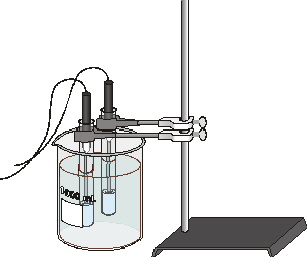Another Look at
Freezing Temperature
In the experiment, “Freezing and Melting of Water,” you saw that the temperature of pure water remained constant at its freezing temperature as it froze and melted. You will now observe what happens when a different pure substance, phenyl salicylate, freezes. Using a second Temperature Probe and sample, you will also see the effect on the freezing temperature when a small amount of another substance, benzoic acid, is dissolved in the phenyl salicylate.
OBJECTIVES
In this experiment, you will
• Observe what happens when phenyl salicylate freezes.
• See the effect on the freezing temperature when a small amount of benzoic acid is dissolved in the phenyl salicylate.
MATERIALS
LabQuest |
2 utility clamps |
LabQuest App |
test tube with phenyl salicylate |
2 Temperature Probes |
test tube with phenyl salicylate & benzoic acid |
1 liter beaker |
2 crystals of solid phenyl salicylate |
ring stand |
thermometer (optional) |
PROCEDURE
1. Obtain and wear goggles.
2. Connect the Temperature Probes to LabQuest and choose New from the File menu. If you have older sensors that do not auto-ID, manually set up the sensors.
3. Fill a 1 liter beaker about 4/5 full with water at a temperature in the range 30–32°C. This temperature can be obtained by blending hot and cold tap water. This water temperature should be measured with a thermometer or Temperature Probe. Place the 1 liter beaker on the base of the ring stand.
4. Obtain 2 crystals of solid phenyl salicylate to use in Step 10.
5. On the Meter screen, tap Rate. Change the data-collection rate to 0.5 samples/second (interval of 2 seconds/sample) and the data-collection length to 900 seconds. Select OK.
6. Identify each of the Temperature Probes.
a. Probe 1 will monitor the temperature of phenyl salicylate and be connected to Channel 1.
b. Probe 2 will monitor the temperature of the benzoic acid-phenyl salicylate mixture and be connected to Channel 2.
Important: Plan ahead for quick positioning of the probes and test tubes in Step 8!

Figure 1
7. When everything is ready, use two utility clamps to obtain test tubes containing the two hot liquids from your teacher. While one team member obtains the melted phenyl salicylate, another can get the melted benzoic acid-phenyl salicylate mixture. Fasten the utility clamps at the top of the test tubes to carry them back to your lab station. CAUTION: Be careful not to spill the hot liquids and do not touch the bottom of the test tubes.
8. Immediately insert Probe 1 into the hot phenyl salicylate and Probe 2 into the hot benzoic acid-phenyl salicylate mixture. Then attach the clamps to the ring stand with the test tubes still above the water. About 30 seconds are required for the probes to warm up to the temperature of their surroundings and give correct temperature readings.
After the 30 seconds have elapsed, start data collection. A live graph of temperature vs. time for both Probe 1 and Probe 2 is being plotted on the screen. The live readings are displayed to the right of the graph.
9. Lower one test tube, then the other, into the water bath as shown in Figure 1. Make sure the water level outside the test tubes is higher than the liquid levels inside the test tubes. Probe 1 is now monitoring the phenyl salicylate and Probe 2 is monitoring the benzoic acid-phenyl salicylate mixture. Important: If the temperature at the start of the graph was not above 50°C for either one of your Temperature Probes, obtain two more samples and begin again.
10. With a very slight up and down motion of both probes, continuously stir the liquids during the cooling. Hold the tops of the probes and not their wires. If no solid appears in either test tube by the time the temperature drops below 39°C, add a crystal of solid phenyl salicylate to the liquid.
11. When either probe begins to stick in the phenyl salicylate, stop stirring. Continue on with the experiment until data collection stops after 15 minutes (or stop data collection before 15 minutes has elapsed). Disconnect the Temperature Probes from LabQuest and set it aside while you finish Steps 12 and 13.
12. After collecting data, if a Temperature Probe has frozen into the phenyl salicylate, use the hot water bath provided by your teacher to melt it out. Do not attempt to pull the probe out—this might damage it!
13. Return the test tubes containing the phenyl salicylate and the benzoic acid-phenyl salicylate mixture to the places directed by your instructor. Proceed directly to Step 1 of Processing the Data.
Processing the data
1. Based on your data, what was the initial freezing temperature of pure phenyl salicylate (Probe 1 in CH 1) and the benzoic acid-phenyl salicylate mixture (Probe 2 in CH 2)? Record t2 and t1 for both probes. (optional) Print a copy of the graph. Label the two curves on the graph as pure phenyl salicylate or benzoic acid-phenyl salicylate mixture.
2. How are the curves on the two graphs different? You should see at least two effects that dissolving benzoic acid in phenyl salicylate had on the freezing process.
3. Based on this lab, what method could a chemist use to determine whether an unknown liquid is pure or has an impurity dissolved in it?
DATA TABLE
Freezing temperature, phenyl salicylate |
°C |
Freezing temperature, benzoic acid-phenyl salicylate mixture |
°C |